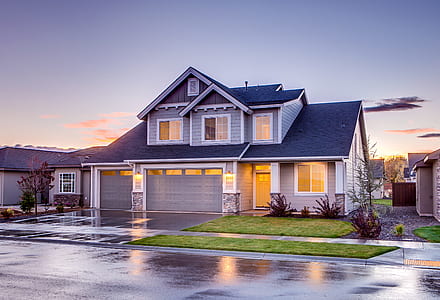Roof stains make the house look worn and shabby. No matter how much you work for the outside of your house and property. Planning to spend your time manicuring the garden, then don’t forget to take a look at your roof. Dirty roofs are eyesores but you can bring back your house to life by cleaning the roof.
Causes Of Roof Stains
The sides of the roof that get less sunlight are more exposed to the elements and are prone to stains algae growth and damages.
Black streaks formed on the roof are a result of algae colonies living in roof shingles. If the new roof of your house was treated by Algicide it is effective for 10 years. After it washes off the roof becomes vulnerable to algae growth. Asphalt shingles are prone to developing algae feeding off the moist air and the limestones in your roof shingles.
Algae start loosening the asphalt and loosen the gravel. This can cause damage to the roof and the roof may require a full replacement.

If you want to learn how to clean roof stains read the steps mentioned below:-
Tools Required
- Cleaner
- Pump sprayer
- Garden hose with a garden sprayer
- Protective gear (Safety glasses or goggles, Safety rope)
- Rubber gloves
- Old clothes
- Slip-resistant shoes
- Ladder
Process:-
- Safety comes first- cleaning the roof can be a dangerous process and it becomes even scarier when the roof is wet. Therefore taking safety precautions while working on the roof is very important to make sure to wear slip-resistant shoes, use a safety harness and avoid going on steep roofs. It is important to protect your eyes and skin when working with harsh chemicals. Chlorine bleach and oxygen bleach an kill the plants so before starting the work wet down plants, shrubs and grasses in your garden before and after using the bleach on the roof. Cover bushes with plastic sheets.

Image source - Cleaning- it is the best to start the roof algae cleaning work on an overcast day to avoid the cleaner from evaporating too quickly. If you know any shingle manufacturers, contact them and check their websites for any recommendations. When using oxygen bleach or any other cleaning products make sure to follow the directions specified on the container.
The basic formula for making cleaning bleach
- 1-quart bleach or 6% sodium hypochlorite
- 1/4 cup trisodium phosphate or other heavy-duty cleaners (avoid using ammonia)
- 1-gallon water
Pour all the ingredients into a garden sprayer or pump, mix well, and spray. After the roof is properly wet with the solution, allow the formula to sit on the roof for about 15 minutes.

- Drag off the Curd– use backward and forward motion to drag the rinsing tool as if you are vacuuming. Place the three water jets/pressure washer at a right angle to blast off any dead algae colonies. Mix the cleaning products with water in a 1:7 ratio. Pour it into pump sprayer, tie yourself to the harness and climb on the roof. Spray water on the roof before spraying cleaner to prevent it from drying quickly. After spraying the cleaner on the roof shingles. If the stain is light use garden hose sprayer to rinse of the cleaning solution. Go slow and in even strokes. If you are not careful, you will end up clean patches alongside the dirty patches that were skipped over. If the roof is severely stained, use a garden nozzle will not exert strong pressure to be able to dislodge the stains. Therefore, you will need specialized rinsing tools in such a case.
Choosing the right chemicals
You will find hundreds of posts on roof cleaning and then buy household bleach and power washer at the lowest pressure within 10 minutes of reading the post.
This approach is not right. Even when you use power washer at the lowest pressure it can damage the shingles. Additionally, chlorine bleach is very harsh and can damage the metal roof flashings, gutters, and downspouts. It will lighten the roof color and the beach runoffs are harmful to plants. Bleach helps in killing the top algae layer and lightening the stains on the roof but it cannot kill the algae lying beneath. And the algae colony starts spreading again.
Sodium hydroxide products work better than bleach and not as harmful for the plants and grass. But it requires you to wear full protective gear. Try to find eco friendly and noncorrosive products.
How to prevent Re-growth?
Algae can grow in as little as one year depending upon the weather conditions of the city you live in. there two different ways to slow down the re-growth of roof algae.
- Install zinc strips or copper strips along the entire roof ridge. Rainwater picks up the algae killing ions and then spreads it on the entire roof. But when it’s not raining algae still feed off the humidity.

image source - Spray a coating of stain-blocking solution. This can protect the roof for 3 years from algae re-growth. Apply it right after you have cleaned the roof.
No matter what method you choose you will still see algae growth after a few years. Cleaning the roof to avoid stains and algae continuously is the only method to keep the roof protected.
How to make shingles last longer?
Use roof shingles that are already treated with algicide which helps in keeping the algae growth at bay for up to 10 years. After the algicide wears off, the roof hosts a buffet for neighborhood algae spores. Clean the shingles as soon as you notice algae growth.
Hiring professional roof cleaners:-

If you are scared climbing on the slippery roof or if you are worried that the warranty for shingles will become void if you clean the roof yourself, it is a good idea to contact a professional roof cleaning service. It is important to get rid of those black and ugly algae stains on the roof. Before calling any random service provider make sure to check their credibility. Go through previous customer reviews on the company’s website. Compare prices and services offered by different companies. You can also ask you, friends and family, for any references.

















